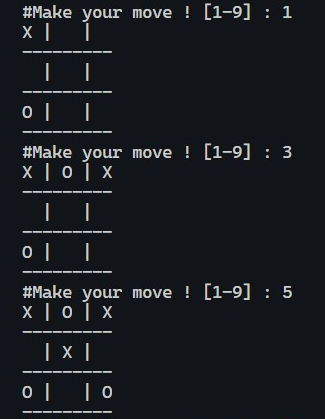Tic-tac-toe is a very popular game, so let’s implement an automatic Tic-tac-toe game using Python.
The game is automatically played by the program and hence, no user input is needed. Still, developing
a automatic game will be lots of fun. Let’s see how to do this.
pip install sys
pip install random-> Mostly probably you should already have OS. datetime, time and random libraries installed as it comes with python distribution.
-Install the given libraries
-Download the code from the given github repository
-Save your desired video link in file
-Run the code
Importing libraries
import random
import sysDefining Variables. board variable contains number that are actually the grid numbers of the game.
board=[i for i in range(0,9)]
player, computer = '',''
moves=((1,7,3,9),(5,),(2,4,6,8))
winners=((0,1,2),(3,4,5),(6,7,8),(0,3,6),(1,4,7),(2,5,8),(0,4,8),(2,4,6))
tab=range(1,10)This function, print_board(), creates the board or the basic layout of the game.
def print_board():
x=1
for i in board:
end = ' | '
if x%3 == 0:
end = ' \n'
if i != 1: end+='---------\n';
char=' '
if i in ('X','O'): char=i;
x+=1
print(char,end=end)This functions just lets you select the character 'X' or 'O'.
def select_char():
chars=('X','O')
if random.randint(0,1) == 0:
return chars[::-1]
return charsThis functions checkes if the desired move is possible or not.
def can_move(brd, player, move):
if move in tab and brd[move-1] == move-1:
return True
return FalseThis functions checks if the user has already won with the previous moves.
def can_win(brd, player, move):
places=[]
x=0
for i in brd:
if i == player: places.append(x);
x+=1
win=True
for tup in winners:
win=True
for ix in tup:
if brd[ix] != player:
win=False
break
if win == True:
break
return winmake_move() function takes the move and remembers it. It also prints the choices in next board print.
def make_move(brd, player, move, undo=False):
if can_move(brd, player, move):
brd[move-1] = player
win=can_win(brd, player, move)
if undo:
brd[move-1] = move-1
return (True, win)
return (False, False)This functions is invoked automatically after the user choice to let the random computer choice.
def computer_move():
move=-1
for i in range(1,10):
if make_move(board, computer, i, True)[1]:
move=i
break
if move == -1:
for i in range(1,10):
if make_move(board, player, i, True)[1]:
move=i
break
if move == -1:
for tup in moves:
for mv in tup:
if move == -1 and can_move(board, computer, mv):
move=mv
break
return make_move(board, computer, move)Returns if the board is complete or not.
def space_exist():
return board.count('X') + board.count('O') != 9This is the main driving code of the game.
player, computer = select_char()
print('Player is [%s] and computer is [%s]' % (player, computer))
result='%%% Deuce ! %%%'
while space_exist():
print_board()
print('#Make your move ! [1-9] : ', end='')
move = int(input())
moved, won = make_move(board, player, move)
if not moved:
print(' >> Invalid number ! Try again !')
continue
if won:
result='*** Congratulations ! You won ! ***'
break
elif computer_move()[1]:
result='=== You lose ! =='
break;
print_board()
print(result)


